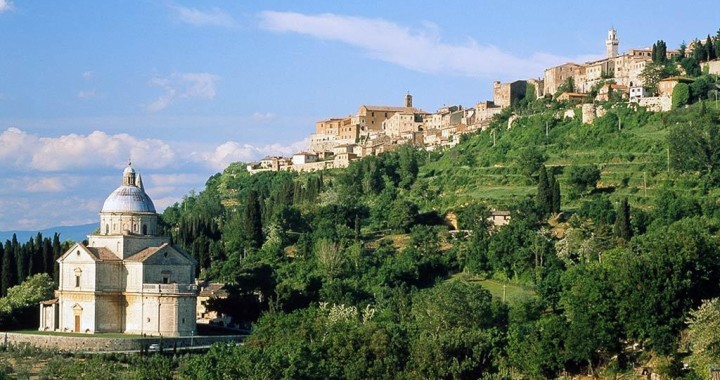A.m. Montepulciano
Duration: 150 minutes – Tour Topics and Highlights: History, architecture, Vino Nobile .
High on a hill, the town offers panoramic views of the valley that produces the noted Vino Nobile. Hidden beneath the steep and winding streets are its passageways and wine cellars, some open to visitors via its many shops. Its 16th century Cathedral houses great works by Taddeo di Bartolo, Andrea della Robbia and Michelozzo.
Did you know? The “MID-SUMMER NIGHT DREAM” was filmed here.
Itinerary: The guided tour starts from the true masterpiece of Renaissance architecture in Montepulciano, the San Biagio temple, a work of Antonio da Sangallo il Vecchio. One km away from the centre of the town, it is a prime example of harmonious and solid construction, on a Greek cross plan with all the facades identical except from the principal one, enriched by the presence of two bell towers, one of which is unfinished. The entire building was constructed in travertine stone between 1518 and about 1545. The Piazza Grande is the monumental centre of the town. On the left is the Palazzo Comunale, designed by Michelozzo as a late 14th-century variation in travertine on Florence’s Palazzo Vecchio. Then you see the Cathedral, that keeps inside valuable works of art, amongst which the most significant are the Aragazzi Funeral monument and the Lily Altar by Andrea della Robbia.
P.m. Pienza
Duration: 70 minutes – Tour Topics and Highlights: History, architecture, urban planning.
Built on a hill that dominates the Val d’Orcia, in the southern Siena’s province, Pienza is a completely intact, elegant Renaissance town, proclaimed a UNESCO World Heritage of Humanity site (1996) for its important example of Renaissance urban planning, architecture and monuments. Pope Pius II (Enea Silvio Piccolomini), a great humanist, commissioned his native village of Corsignano to be transformed from a medieval town to a splendid Renaissance city. Built of local yellow-ochre and white travertine stone, the pedestrian town of Pienza was designed by one of the most famous Florentine architects of his time, Bernardo Gambarelli known as the Rossellino, and built between 1459 and 1462. The itinerary includes the exceptional Cathedral, whose Renaissance façade hides a gothic interior Piazza Pio II and urban planning review Palazzo Piccolomini and Palazzo Borgia’s courtyards the Renaissance buildings the medieval districts the panoramic streets, from where the splendid landscape of the Val d’Orcia can be admired.


